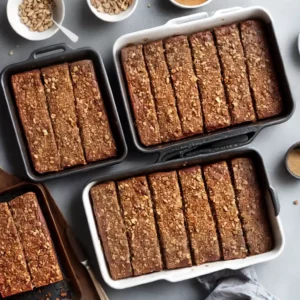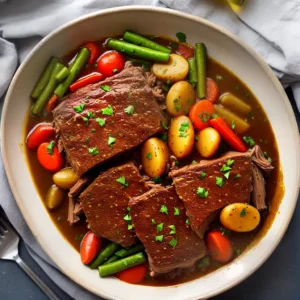Reheating rice can be a challenge as it tends to dry out and become chewy. However, with the right techniques, you can ensure that your reheated rice stays fluffy and delicious. In this article, I will guide you through the process of reheating rice and share tips to keep it fluffy.
Key Takeaways:
- Properly storing leftover rice is crucial for maintaining its texture and taste when reheating.
- Reheating rice on the stove involves adding a splash of liquid and heating over low heat to retain moisture.
- Microwaving rice requires short intervals, fluffing in between, and preventing it from becoming too dry.
- Oven reheating provides a gradual process to maintain moisture in the rice.
- Stir-frying is an excellent option for repurposing leftover rice and reviving its texture and flavors.
Why Proper Storage is Important
Properly storing leftover rice is crucial to maintain its texture and taste when reheating. When stored incorrectly, rice can dry out and lose its fluffy, moist consistency. To prevent this from happening, it is important to follow a few key rice storage tips.
First and foremost, leftover rice should be refrigerated within four days of cooking. This helps slow down the growth of bacteria and keeps the rice fresh. Before storing, allow the cooked rice to cool down to room temperature. This prevents condensation from forming inside the container, which can lead to moisture buildup and make the rice soggy.
Airtight containers are highly recommended for storing cooked rice. These containers help retain moisture in the grains and prevent outside odors from affecting the rice’s flavor. If you have a large batch of leftover rice that you won’t consume within four days, consider freezing it. Freezing rice is an effective way to extend its shelf life. When you’re ready to use the frozen rice, thaw it in the refrigerator overnight or heat it using the reheating methods described in the following sections.
Preventing Rice from Drying Out
When reheating rice, it is essential to prevent it from drying out. To achieve this, you can add a splash of water or broth to the rice before reheating it. This additional moisture helps retain the fluffiness and prevents the rice grains from becoming hard and dry. Additionally, covering the rice while reheating, whether in the microwave or on the stove, traps steam and keeps the rice moist.
Another tip to prevent rice from drying out is to reheat it in appropriate portions. It is best to reheat smaller quantities of rice at a time rather than reheating a large batch. This ensures that each portion of rice heats evenly and thoroughly, preventing some parts from becoming dry and others from being too moist.
Summary
Proper storage of leftover rice is vital to maintain its texture and flavor when reheating. Refrigerate cooked rice promptly, cool it down before storing, and use airtight containers to retain moisture. Freezing rice is an option for longer storage. To prevent rice from drying out during reheating, add a splash of liquid and cover it while heating. Reheating in appropriate portions also helps maintain the moisture in the rice.
Reheating Rice on the Stove
One of the stovetop methods for reheating rice involves using a shallow pot or skillet. This technique helps restore the fluffy texture of the rice while adding a splash of liquid to prevent drying out. Here’s how to do it:
- Transfer the desired amount of rice to a shallow pot or skillet.
- Add a splash of liquid, such as water or broth, to the pot.
- Cover the pot tightly to trap the steam and heat the rice evenly.
- Place the pot on the stove over low heat and let it warm up for about 5 minutes.
- Stir the rice occasionally to break up any clumps and distribute the heat evenly.
- Once the rice is thoroughly heated, it’s ready to serve and enjoy!
This stovetop method is simple yet effective in reviving the fluffy texture of reheated rice. The low heat and steam created in the pot help to retain moisture and prevent the rice from becoming dry or chewy.
Remember to use a shallow pot or skillet when reheating rice on the stove. The wide surface area allows the rice to heat evenly and ensures that the grains stay fluffy.
Now that you know how to reheat rice on the stove, let’s explore other methods such as microwaving, oven reheating, and stir-frying in the following sections.
| Method | Pros | Cons |
|---|---|---|
| Stovetop | – Even heating – Retains moisture |
– Requires stovetop cooking – Need to watch for clumping |
| Microwave | – Quick and convenient – Minimal cleanup |
– Potential for uneven heating – Rice can become dry if overcooked |
| Oven | – Suitable for larger quantities – Gradual reheating process |
– Longer cooking time – May take up oven space |
| Stir-frying | – Revives texture and flavors – Versatile for adding ingredients |
– Requires additional ingredients – Not suitable for all rice dishes |
Microwaving Reheating Method
When it comes to reheating rice quickly and conveniently, the microwave is your best friend. It’s a simple and efficient method that can have your rice warmed up and ready to eat in no time. To reheat rice in the microwave, follow these easy steps:
- Place the desired amount of rice in a microwave-safe dish.
- Break up any clumps with a fork to ensure even heating.
- Add a small amount of water or broth to the dish. This will help create steam and prevent the rice from drying out.
- Cover the dish with a damp paper towel or napkin. This will trap moisture and keep the rice fluffy.
- Heat the rice in the microwave in short intervals, stirring in between. This will help distribute the heat evenly and prevent overcooking.
- Once the rice is heated through, remove it from the microwave and fluff it with a fork.
By following these steps, you can ensure that your reheated rice retains its moisture and fluffy texture. Just be careful not to overheat the rice, as this can cause it to become dry and rubbery.

Tips for Fluffy Microwaved Rice
To achieve the fluffiest microwaved rice every time, here are a few extra tips:
- Use a microwave-safe container with a lid or cover to help create a steamy environment for the rice.
- Add a small amount of oil or butter to the rice before reheating to prevent sticking and add flavor.
- For larger portions of rice, divide it into smaller, microwave-safe containers to ensure even heating.
- Let the rice sit for a minute or two after reheating to allow the heat to distribute evenly throughout the grains.
With these tips in mind, you can confidently reheat rice in the microwave and enjoy a fluffy and delicious meal every time.
Oven Reheating Technique
When it comes to reheating rice, using the oven can be an effective method that preserves the fluffy texture. Preheating the oven to 300°F allows for a gradual reheating process that helps maintain the moisture in the rice. Here’s how you can use the oven to reheat your rice:
- Preheat the oven to 300°F.
- Spread the desired amount of rice in an oven-safe baking dish.
- Add a splash of water or broth to the rice to prevent it from drying out.
- Cover the baking dish tightly with foil to trap the heat and moisture.
- Bake the rice for about 20 minutes or until it is heated through.
This oven reheating technique works well for larger quantities of rice, making it a convenient option for family meals or gatherings. The gradual reheating process ensures that the rice is evenly heated and maintains its fluffy texture.
Using the oven to reheat rice is a great option when you want to reheat a large batch or if you’re looking for a method that requires minimal attention. Just pop the rice in the oven, set the timer, and let it do its magic. The result is perfectly heated rice that is ready to be enjoyed!
As with any reheating method, it’s important to store leftover rice properly to maintain its quality. Refrigerating cooked rice within 4 days and using airtight containers can help prevent the rice from drying out. By following these tips and using the oven reheating technique, you can enjoy fluffy and delicious reheated rice.
| Pros | Cons |
|---|---|
| Evenly reheats larger quantities of rice | Requires longer reheating time compared to other methods |
| Retains moisture in the rice | Not as quick as microwaving |
| Convenient for family meals or gatherings | Requires the use of an oven and baking dish |
Stir-Frying Reheating Method
When it comes to repurposing leftover rice, stir-frying is a fantastic option that brings new life to your meal. By stir-frying rice, you can transform cold leftovers into a delicious and satisfying dish.
To use the stir-frying method, start by heating oil in a pan or wok over medium-high heat. Once the oil is hot, add the cold rice and stir-fry for a few minutes until the rice is heated through. The high heat of stir-frying helps revive the texture and flavors of the rice, giving it a slightly crispy texture on the outside while remaining fluffy on the inside.
Enhance your stir-fried rice by adding your favorite vegetables and protein. You can toss in some chopped bell peppers, carrots, peas, or any other vegetables you have on hand. For protein, consider adding cooked chicken, shrimp, or tofu. Season with soy sauce, garlic, and ginger for a tasty stir-fry that is sure to satisfy your cravings.
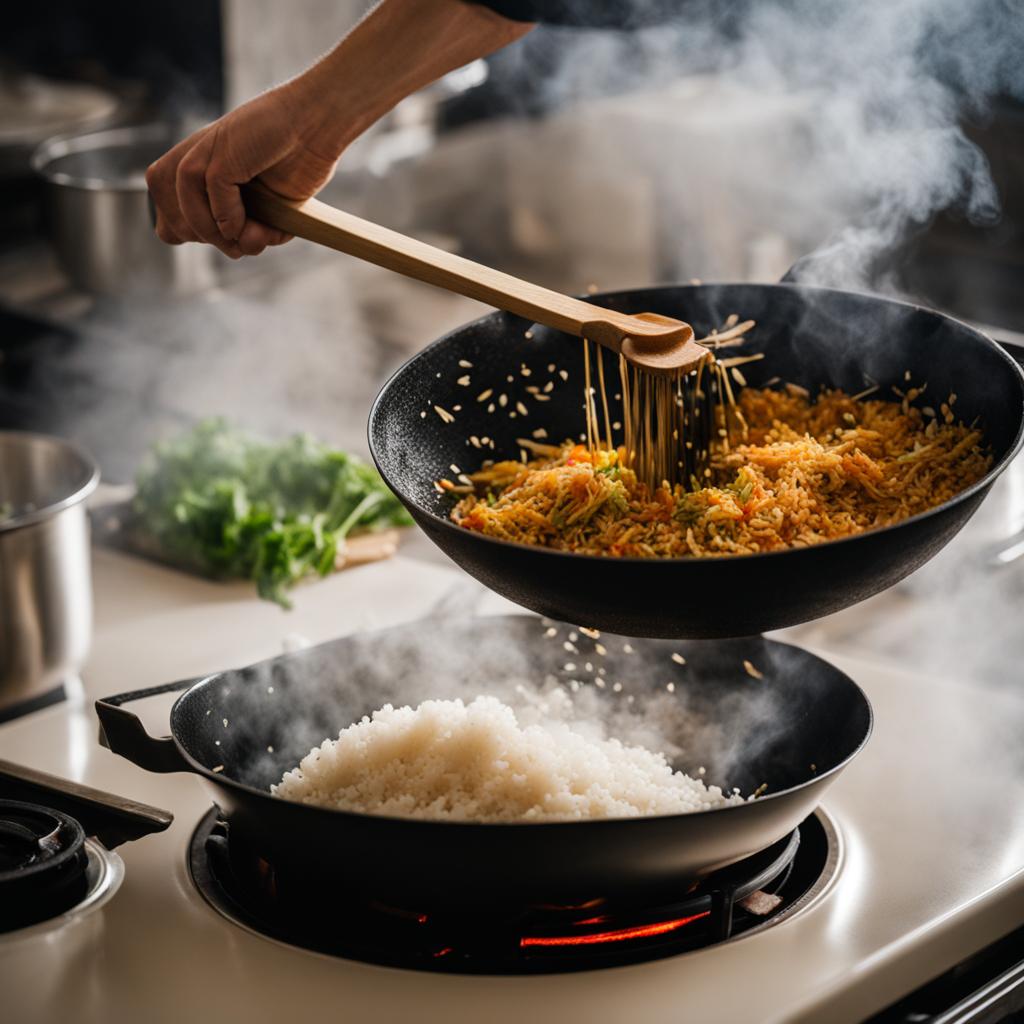
Tips for Stir-Frying Rice Leftovers
- Ensure the rice is cold and not clumped together before stir-frying.
- Use a non-stick pan or well-seasoned wok to prevent the rice from sticking.
- Stir-fry the rice at a high heat to achieve the desired texture and crispiness.
- Add the vegetables and protein towards the end of stir-frying to avoid overcooking them.
- Customize your stir-fry with your favorite sauces and seasonings for added flavor.
With the stir-frying method, you can turn leftover rice into a delicious meal in just a few minutes. It’s a versatile technique that allows for creative experimentation, making it a go-to option for using up rice leftovers.
Reheating Rice Dishes
When it comes to reheating rice dishes, most options are suitable, except for cream-based rice dishes like risotto. With proper techniques, you can enjoy a hot and fully reheated meal. It is recommended to reheat rice dishes in smaller portions to ensure even heating and avoid cold spots.
Layering the ingredients or reheating each component separately can help achieve the desired results. By taking these steps, you’ll be able to savor the flavors and textures of your favorite rice dishes without compromising their quality.
Here are some popular rice dishes that can be successfully reheated:
- Vegetable Fried Rice
- Chicken and Rice Casserole
- Beef Stir-Fry with Rice
- Shrimp and Rice Pilaf
These dishes are well-suited for reheating as the flavors tend to meld together, enhancing the overall taste. To reheat, simply follow the instructions for the chosen reheating method, ensuring that the rice is thoroughly heated to a safe temperature.
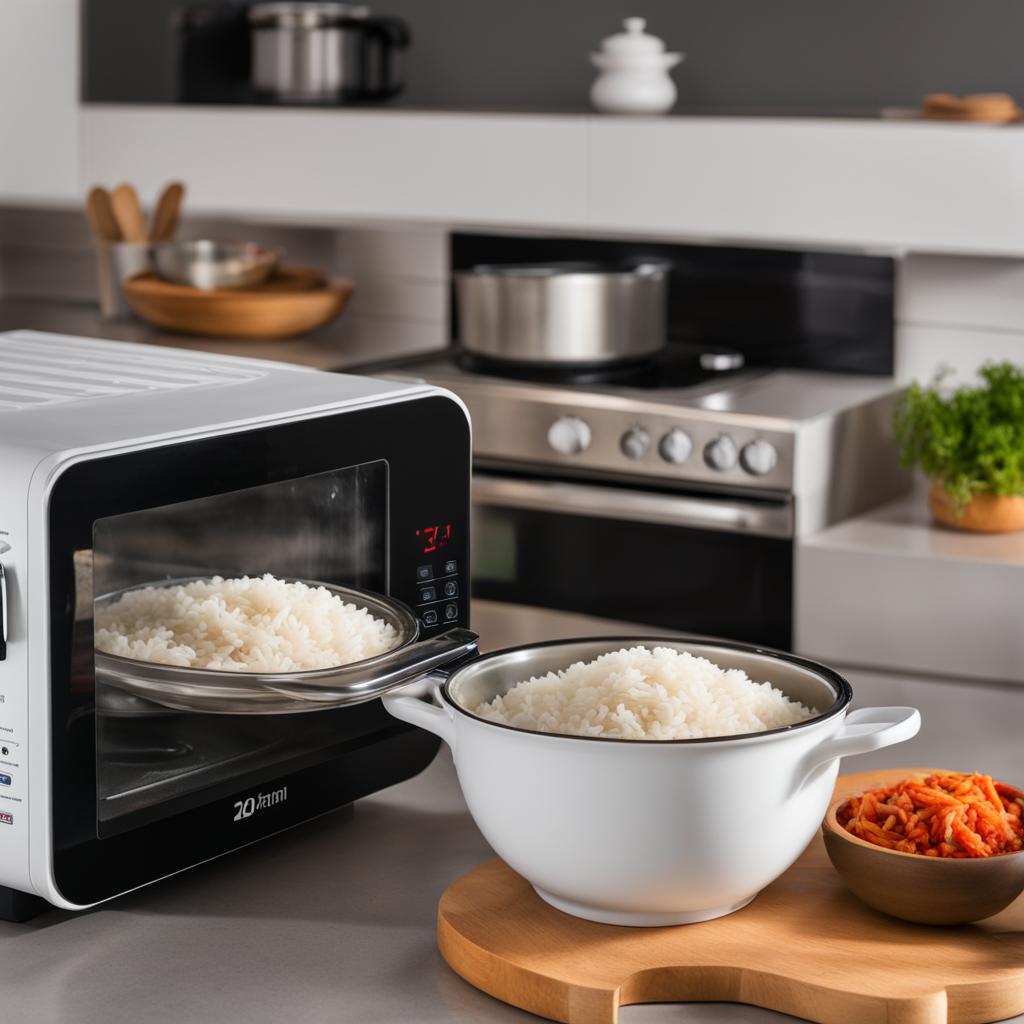
Tips for Reheating Rice Dishes
Here are some additional tips to keep in mind when reheating rice dishes:
- For best results, reheat rice dishes in smaller portions.
- If reheating in the microwave, cover the dish with a microwave-safe lid or microwave-safe plastic wrap to create steam.
- When using the oven, ensure the dish is covered tightly with foil to retain moisture.
- If stir-frying, heat the rice dish on medium-high heat to prevent sogginess.
By following these tips, you can enjoy delicious, reheated rice dishes that taste just as good as freshly cooked ones.
| Rice Dish | Reheating Method | Time |
|---|---|---|
| Vegetable Fried Rice | Stir-frying | 3-5 minutes |
| Chicken and Rice Casserole | Oven | 20-25 minutes |
| Beef Stir-Fry with Rice | Stir-frying | 3-5 minutes |
| Shrimp and Rice Pilaf | Microwave or stove | 5-7 minutes |
Tips for Fluffy Reheated Rice
When it comes to reheating rice, achieving a fluffy texture is key to enjoying this versatile grain. Here are some helpful tips to ensure your reheated rice remains light, fluffy, and oh-so-delicious.
Add a touch of oil or butter
One of the secrets to keeping reheated rice fluffy is to add a small drizzle of oil or a pat of butter while reheating. This helps to soften the grains and prevent them from sticking together, resulting in a more delightful texture. Simply drizzle a little oil or add a pat of butter to your reheating method, whether it’s on the stove, in the microwave, or in the oven.
Cover with a damp paper towel
To retain moisture and prevent your reheated rice from drying out, cover it with a damp paper towel or napkin while reheating in the microwave. This helps to create steam, keeping the rice moist and fluffy. Make sure the paper towel is damp but not soaking wet before placing it over the rice.
Use appropriate portions
When reheating rice, it’s essential to use appropriate portion sizes to avoid drying out the grains. Reheating too much rice at once can result in uneven heating and a loss of moisture. Divide the rice into smaller portions and reheat them separately for best results. This ensures that each portion is heated evenly and retains its fluffy texture.
Gently stir during reheating
While reheating your rice, gently stir it every now and then to break up any clumps and ensure even heating. Stirring the rice helps to distribute the heat and moisture throughout, resulting in a more uniform texture. Be careful not to overmix or vigorously stir the rice, as it can cause it to become mushy.
By following these tips, you can ensure that your reheated rice remains fluffy and delicious, ready to be enjoyed as a side dish or as a base for various rice dishes. With the right techniques and a little care, you can savor the perfect fluffy rice every time.
Conclusion
In conclusion, reheating rice can be a challenge, but with the right techniques, you can enjoy fluffy and delicious rice every time. Proper storage is crucial for maintaining the texture and taste of leftover rice. Remember to refrigerate cooked rice within 4 days and use airtight containers to retain moisture. Freezing rice is also an option for longer storage.
When it comes to reheating, there are several methods you can choose from. Reheating on the stove involves adding a splash of liquid and heating over low heat. Microwaving is quick and convenient, but be sure to add some water or broth to prevent dryness. The oven method provides a gradual reheating process, while stir-frying is perfect for repurposing leftover rice into delicious stir-fried dishes.
To achieve fluffy reheated rice, remember to add a small drizzle of oil or butter, cover with a damp paper towel when microwaving, and stir gently to break up clumps. By following these tips and techniques, you can enjoy fluffy reheated rice that tastes just as good as freshly cooked rice.
FAQ
How do I reheat rice and keep it fluffy?
To reheat rice and keep it fluffy, you can use methods such as stovetop reheating, microwaving, oven reheating, or stir-frying. Each method has its own specific instructions to ensure fluffy reheated rice.
Why is proper storage important for leftover rice?
Properly storing leftover rice is important to maintain its texture and taste when reheating. Storing cooked rice in airtight containers and refrigerating it within 4 days helps retain moisture in the grains. Rice can also be frozen for longer storage.
How do I reheat rice on the stove?
To reheat rice on the stove, transfer the desired amount of rice to a shallow pot or skillet. Add a splash of liquid, cover tightly, and heat over low heat for about 5 minutes. Stir occasionally to break up clumps and restore the fluffy texture.
What is the microwaving reheating method?
The microwaving reheating method is quick and convenient. Place the rice in a microwave-safe dish, add a small amount of water or broth, cover with a damp paper towel, and heat in short intervals. Fluff the rice in between until it is heated through, being careful not to overcook and dry it out.
How do I reheat rice in the oven?
To reheat rice in the oven, preheat to 300°F and spread the rice in an oven-safe baking dish. Add a splash of water or broth, cover tightly with foil, and bake for about 20 minutes or until heated through. This gradual reheating process helps maintain the moisture in the rice.
Can I stir-fry leftover rice?
Yes, stir-frying is a great way to repurpose leftover rice. Heat oil in a pan or wok, add the cold rice, and stir-fry for a few minutes until heated through. Add your favorite vegetables and protein to create a delicious stir-fried rice dish.
Can I reheat any rice dish?
Most rice dishes can be successfully reheated, except for cream-based rice dishes like risotto. It is recommended to reheat rice dishes in smaller portions to ensure even heating and avoid cold spots. Layering the ingredients or reheating each component separately can help achieve a hot and fully reheated meal.
What are some tips for fluffy reheated rice?
Here are some tips for fluffy reheated rice:
1. Add a small drizzle of oil or a pat of butter while reheating to soften the rice and prevent sticking.
2. Cover the rice with a damp paper towel or napkin when microwaving to retain moisture.
3. Use appropriate portions for reheating to avoid drying out the rice.
4. Gently stir the rice during reheating to break up clumps and ensure even heating.
What is the conclusion about reheating rice?
Reheating rice requires proper techniques to maintain its fluffy texture and taste. Whether you choose to reheat rice on the stove, in the microwave, in the oven, or through stir-frying, it’s important to follow the specific instructions for each method. Properly storing leftover rice and using the tips provided can help you achieve perfectly reheated, fluffy rice every time.
Source Links
- https://mahatmarice.com/cooking/how-to-reheat-leftover-rice/
- https://www.thekitchn.com/the-best-way-to-reheat-leftover-rice-tips-from-the-kitchn-219088
- https://www.thepioneerwoman.com/food-cooking/cooking-tips-tutorials/a39394170/how-to-reheat-rice/
Related Recipes:
 How to Reheat Pasta Without Losing Flavor
How to Reheat Pasta Without Losing Flavor
 How to Reheat Casseroles: Best Methods Explored
How to Reheat Casseroles: Best Methods Explored
 How to Reheat Lasagna: Keep It Moist and Delicious
How to Reheat Lasagna: Keep It Moist and Delicious
 How to Reheat Quiche and Maintain Its Flavor
How to Reheat Quiche and Maintain Its Flavor
 How to Reheat Mashed Potatoes: Keep Them Creamy
How to Reheat Mashed Potatoes: Keep Them Creamy
 How to Reheat Cinnamon Rolls: Keep Them Soft and Gooey
How to Reheat Cinnamon Rolls: Keep Them Soft and Gooey
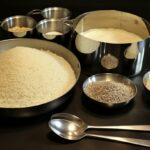 How Much Rice Per Person? (Perfect Measurement Conversion Guide)
How Much Rice Per Person? (Perfect Measurement Conversion Guide)
 How to Reheat Poached Eggs to Perfection
How to Reheat Poached Eggs to Perfection


